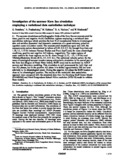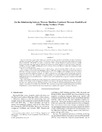Investigation of the summer Kara Sea circulation employing a variational data assimilation technique
| dc.contributor.author | Panteleev, G. | |
| dc.contributor.author | Proshutinsky, A. | |
| dc.contributor.author | Kulakov, M. | |
| dc.contributor.author | Nechaev, A. | |
| dc.contributor.author | Maslowsk, W. | |
| dc.date.accessioned | 2015-04-13T22:44:58Z | |
| dc.date.available | 2015-04-13T22:44:58Z | |
| dc.date.issued | 2007 | |
| dc.identifier.citation | Panteleev, G., A. Proshutinsky, M. Kulakov, D. A. Nechaev, and W. Maslowski (2007), Investigation of the summer Kara Sea circulation employing a variational data assimilation technique, Journal of Geophysical Research, Vol. 112, C04S15, doi:10.1029/2006JC003728. | en_US |
| dc.identifier.uri | https://hdl.handle.net/10945/44937 | |
| dc.description | The article of record as published may be located at http://dx.doi.org/10.1029/2006JC003728 | en_US |
| dc.description.abstract | The summer circulations and hydrographic fields of the Kara Sea are reconstructed for mean, positive and negative Arctic Oscillation regimes employing a variational data assimilation technique which provides the best fit of reconstructed fields to climatological data and satisfies dynamical and kinematic constraints of a quasi-stationary primitive equation ocean circulation model. The reconstructed circulations agree well with the measurements and are characterized by inflow of 0.63, 0.8, 0.51 Sv through Kara Gate and 1.18, 1.1, 1.12 Sv between Novaya Zemlya and Franz Josef Land, for mean climatologic conditions, positive and negative AO indexes, respectively. The major regions of water outflow for these regimes are the St. Anna Trough (1.17, 1.21, 1.34 Sv) and Vilkitsky/Shokalsky Straits (0.52, 0.7, 0.51 Sv). The optimized velocity pattern for the mean climatological summer reveals a strong anticyclonic circulation in the central part of the Kara Sea (Region of Fresh Water Inflow, ROFI zone) and is confirmed by ADCP surveys and laboratory modeling. This circulation is well pronounced for both high and low AO phases, but in the positive AO phase it is shifted approximately 200 km west relatively to its climatological center. During the negative AO phase the ROFI locaion is close to its climatological position. The results of the variational data assimilation approach were compared with the simulated data from the Hamburg Shelf Ocean Model (HAMSOM) and Naval Postgraduate School 18 km resolution (NPS-18) model to validate these models. | en_US |
| dc.rights | This publication is a work of the U.S. Government as defined in Title 17, United States Code, Section 101. Copyright protection is not available for this work in the United States. | en_US |
| dc.title | Investigation of the summer Kara Sea circulation employing a variational data assimilation technique | en_US |
| dc.type | Article | en_US |





